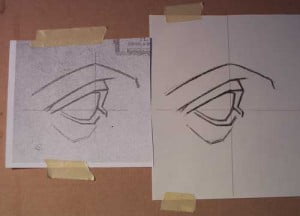Plate 1.3

This plate was another hard one. It took me 3 tries at 2 hours a piece to get an accurate drawing. It is taking me some time to get used to this sight-size method, although I am seeing some benefits of using the technique. Namely, it is much easier to see major errors than if the drawing board were on my lap. You must keep in mind that my complaining about the drawings being inaccurate is mainly revolving around minute details that add up to a less-than-perfect copy. Since my object here, however, is not to make something that’s “pretty close”, but a completely accurate copy, I feel the complaining is justified.
After the third attempt, the only thing that was off by more than a tiny bit was the line coming up from the very bottom of the eye socket on the bottom right of the drawing. My drawing has it sticking way out to the right. This led me to consider the advice offered by Mr. Rousar in his book Cast Drawing Using the Sight-Size Method: Take plenty of breaks! As I sit now and compare the two drawings I wonder how it was that I couldn’t have seen the obvious problem with that line. While I was working, however, it was the proverbial snake that would have bitten me… I noticed the same thing with plate 1.2. There seemed to be fairly obvious structural errors that I just couldn’t see anymore after staring at it for hour upon hour. I must remember to curb my enthusiasm to “check one more item off the list” when it interferes with the accuracy of the finished product.
Plate 1.4

This one was basically the reverse of 1.3. I managed to get a very accurate copy on the first try, and only noticed one problem at the end: The entire drawing was correctly in proportion vertically, but it was just slightly squeezed horizontally throughout the entire drawing. This was interesting to me… I wonder, did one incorrect horizontal measurement drive the entire thing off course, or do I need to somehow compensate on all of my horizontal measurements by making the marks on the paper a tiny bit wider than the distance I see with my plumb-line?
On the whole, I felt this drawing went much better than the last two. It still took me a good hour and-a-half, if not longer, to complete, but I had much more confidence in my measurements throughout the process.